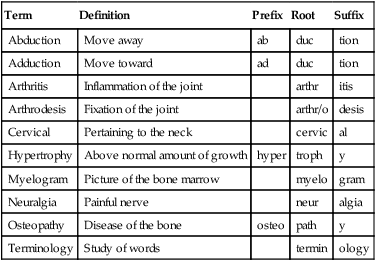Chapter 33 Health Information and Administration Terminology* *A transition syllable or vowel may be added to or deleted from the word parts to make the combining form. Even though health care administrators and information personnel often do not have direct contact with the patients, they are of critical importance to the quality of care delivered (Table 33-1). Health care managers need to be organized to work quickly and accurately. Good communication skills are necessary to provide information and leadership in the health care setting. Administrators must be able to form and maintain good working relationships with those in subordinate positions. Although administrators and information personnel may not have direct contact with the patient, they are subject to confidentiality and other Health Insurance Portability and Accountability Act (HIPAA) guidelines. More information about these guidelines is found in Chapter 2. With the exception of high-level managers, most health information and administrative service personnel work regular hours. Some examples of careers in administration include health care facility managers, supervisors, medical secretaries, unit coordinators, and medical records (health information) personnel (Box 33-1). TABLE 33-1 Information and Administration Career Educational Cost and Earnings *http://www.bscc.cc.al.us/tuition.html. Administrators coordinate services, hiring, and training of personnel (Fig. 33-1). Administrators may be responsible for establishing the policies and procedures of the facility. The CEO must demonstrate public relations skills as well as leadership ability. Long, irregular hours are often required for public speaking and travel. Human resource and labor relations personnel recruit, screen, and hire qualified employees and match them to appropriate jobs. They may also provide training and development opportunities to increase employee satisfaction and decrease turnover. They may interview prospective employees, explain benefits of employment, and supervise background checks before hiring occurs (Box 33-2). In 2004 the Joint Commission mandated that criminal background checks be performed on any person who interacts with patients. This includes staff, students, and volunteers. The Fair Credit Reporting Act defines the guidelines for requesting or requiring background checks. In some cases human resource personnel may act as mediators or arbitrators to resolve employment disputes. The education required for human resources varies with the duties and level of responsibility required. A bachelor’s degree is a typical entry level, but master’s degrees in human resources administration are available. Certification is available for the Certified Employee Benefits Specialist, and the Society for Human Resource Management offers two levels of certification for more senior personnel.
Information and Administration Careers
 Identify at least 10 terms related to health care information and administration.
Identify at least 10 terms related to health care information and administration.
 Specify the role of selected information and administrative health care workers, including personal qualities, levels of education, and credentialing requirements.
Specify the role of selected information and administrative health care workers, including personal qualities, levels of education, and credentialing requirements.
 Identify three personal characteristics needed in an efficient health occupations clerk.
Identify three personal characteristics needed in an efficient health occupations clerk.
 Identify at least five forms used as part of the medical record.
Identify at least five forms used as part of the medical record.
Term
Definition
Prefix
Root
Suffix
Abduction
Move away
ab
duc
tion
Adduction
Move toward
ad
duc
tion
Arthritis
Inflammation of the joint
arthr
itis
Arthrodesis
Fixation of the joint
arthr/o
desis
Cervical
Pertaining to the neck
cervic
al
Hypertrophy
Above normal amount of growth
hyper
troph
y
Myelogram
Picture of the bone marrow
myelo
gram
Neuralgia
Painful nerve
neur
algia
Osteopathy
Disease of the bone
osteo
path
y
Terminology
Study of words
termin
ology

Careers
Career
Educational Cost*
Earnings†
Registered health information technician (RHIT)
Bishop State Community College, associate degree, 77 credit hours
Fees include:
Tuition, books, & fees $8393
Median annual salary: Mobile, Ala.—$28,450
Heath Service Managers
Information and Administration Careers
Get Clinical Tree app for offline access




























